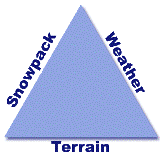Situational Awareness: Skier vs Sledder
Situational Awareness is a risk-management keyword that’s being used more and more often. It basically means the perception of your environment, and comprehension of what your observations mean. It’s used in the context of risk management when some action is taken, and the risk may or may not be properly managed — often when the risk is either not observed, or when conditions have changed without people realizing it.
A concrete example is when someone is driving, and the weather changes. They may start off on dry roads, which then get wet, and later get icy — for instance if they are gaining in elevation. Suddenly the driver may be faced with conditions they are unprepared for both mentally and in terms of the tires on the car. Their activity hasn’t changed, but their situation has.
Mountaineers, climbers and many other backcountry enthusiasts rely on situational awareness for their survival; they constantly observe their environment and change their behaviour to adapt to changes in terrain, weather, or their own abilities. It’s like a feedback loop where the person is constantly evaluating which tools or techniques would be necessary to handle the changes happening around them.
This skill also takes training, and it’s one of the things that sets an expert apart from a beginner in any sport. The beginner learns by rote, and reproduces behaviour according to a set of rules they may have learned. They get into trouble when they apply a rule to the wrong conditions, or fail to perceive the situation that calls for a change in behaviour. A person at the intermediate level is becoming better at making these decisions, and also better at determining when to use certain skills or techniques. An expert can perform at the highest level, adapting tools and techniques easily, and planning not only for the current situation but for possible contingencies in the future.
These millions of small decisions happen constantly, with the person taking input, processing it, and adapting.
Situational awareness also bears on SAR operations quite a bit, but I think I will get into that in another post.
Sledding
I am not a sledder, although I own one, and have taught avalanche courses to sledders; I just don’t do it enough to feel I can be a member of that club. Feel free to correct me here if you think I am wrong.
 Sledders move very quickly; they can tear across the snow at over 80 km/h at times, and they see a lot of terrain in a day. Terrain is one of the major factors underlying the cause of avalanches, the others being the snowpack, and the weather. Changing aspect, altitude and angle have a huge effect on the amount and type of snow, how it changes with respect to the sun and wind, it’s temperature, and how fast or slow it stabilizes.
Sledders move very quickly; they can tear across the snow at over 80 km/h at times, and they see a lot of terrain in a day. Terrain is one of the major factors underlying the cause of avalanches, the others being the snowpack, and the weather. Changing aspect, altitude and angle have a huge effect on the amount and type of snow, how it changes with respect to the sun and wind, it’s temperature, and how fast or slow it stabilizes.
I believe that the speed of the sled puts the rider at a very great disadvantage when evaluating changing snow conditions. They are not situationally aware of the changes in the snow. The number of fatalities backs this up — sledders account for 40% of the avalanche deaths in Canada from 2002 to 2011.
In contrast, a backcountry skier moves very slowly, especially when going uphill. However, this slow pace gives them a much better platform from which to observe conditions around them; they have a lot longer to observe the weather, feel the wind, and observe the snow under their feet. They have an opportunity to constantly evaluate the situation, and make changes to the route or travel techniques.
I’m not saying that all skiers do this, only that they have a clear advantage in the opportunity to observe.
For example, while ski touring near Pemberton a few years ago I remember ascending a slope; the snow underfoot was deep and consistent, but as I approached a ridge line the snow got thinner, began to look chalky, and became very stiff, all in the space of three feet. Cracks shot forward from my skis, and small slabs of snow began to move a little. These are all warning signs of unstable snow. Quickly taking a probe and shovel from my pack, within a few seconds I could dig into the snow and see the layers that were moving.
Being aware of the change in conditions, I chose to switchback, and continue ascending on the safe side of the ridge. Reaching the top, based on my observations while ascending, I evaluated the ski run down to be safe on the side I had ascended.
A sledder in the same situation would never have been able to detect these changes in snow conditions unless they stopped. Someone with a lot of experience would be able to surmise from looking at the shape of certain features of the snow that there had been a wind event in the region, and perhaps would be able to guess that there was an instability – but without actual observations to back it up, this would be guess work.
After all, observations are what make snow science a science.
The only good thing about being on a sled in that situation is that there is a chance that a sledder could outrun an avalanche. You can see this in several videos on YouTube.
Training to Fit
We’re not blaming the victims here, we’re identifying a problem. Sledding is a very different travel technique than skiing, but most avalanche experts are skiers. So how can a skier train a sledder in avalanche awareness? Based on my experience, not very well.
Well, the Canadian Avalanche Association (CAA) is working on just that. They’ve adapted the industry standard Avalanche Operations – Level 1 (Avy 1) to include a snowmobile-based course; and over the next few years they have a bursary program where sledders can apply for a grant to take the course. Anyone taking this course is then qualified to deliver the CAA’s Avalanche Skills Training courses.
You can read more about the bursary program here; basically the idea is that since sledders seem to be a growing demographic in avalanche fatalities, there needs to be a concerted outreach to their community to change the culture of sledding to be aware of the risks, and understand that they can be managed, and avoided. This is a direct result of the 2009 Coroner’s death review panel that was convened because of the unusually large number of sledders who died that year in avalanches.
Whether you’re a skier or a sledder, stay safe out there this winter.

Mike some great in site and having spent more days on my sled then skis the last few years I am u derstaning the difference much better. The travel distance is one of the biggest thing facing sleddders, as a skier I may get on 2-3 different slopes a day. Sleddding many more, my focus has been teaching to see what is happening we many not feel the snow the same but there are many clues we can see and decisions to make that can be safer. But the hardest thing for many people to grasp is nit all sledders high mark many just use a sled to get out. Great topic.
Hey Dave, nice to hear from you.
Most of the sledders I’d seen in the past 3 years are using the sled to access ski terrain, which is new in my experience, but it’s why bought mine. Part of my reason for writing the article was the insight that as I drove the sled I could observe the snow morphology (shape), but I could not observe the snow structure in the same way as I do on skis. So when I stop the sled I’m already in dangerous terrain, and I have a lot of catching up to evaluate the stability.
Certainly when I assisted instructing sledders we advised running the machine over small terrain features to see how they would react before heading into bigger terrain. Sledders need to focus on observation and use the tools they have. They’re at a disadvantage as I said in the article, but as you mention they also see a lot more terrain than a skier, and they need to turn this into their advantage.